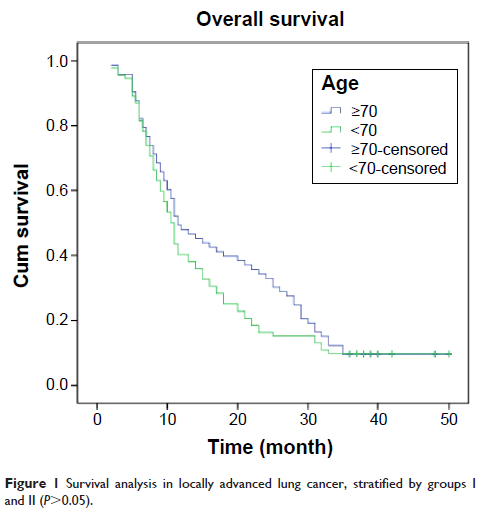109669
论文已发表
注册即可获取德孚的最新动态
IF 收录期刊
- 3.4 Breast Cancer (Dove Med Press)
- 3.2 Clin Epidemiol
- 2.6 Cancer Manag Res
- 2.9 Infect Drug Resist
- 3.7 Clin Interv Aging
- 5.1 Drug Des Dev Ther
- 3.1 Int J Chronic Obstr
- 6.6 Int J Nanomed
- 2.6 Int J Women's Health
- 2.9 Neuropsych Dis Treat
- 2.8 OncoTargets Ther
- 2.0 Patient Prefer Adher
- 2.2 Ther Clin Risk Manag
- 2.5 J Pain Res
- 3.0 Diabet Metab Synd Ob
- 3.2 Psychol Res Behav Ma
- 3.4 Nat Sci Sleep
- 1.8 Pharmgenomics Pers Med
- 2.0 Risk Manag Healthc Policy
- 4.1 J Inflamm Res
- 2.0 Int J Gen Med
- 3.4 J Hepatocell Carcinoma
- 3.0 J Asthma Allergy
- 2.2 Clin Cosmet Investig Dermatol
- 2.4 J Multidiscip Healthc

已发表论文
晚期非小细胞肺癌 (NSCLC) 老年患者的特性和预后分析
Authors Gao Y, Gao F, Ma J, Zhang X, Li Y, Song L, Zhao D
Received 21 April 2015
Accepted for publication 12 June 2015
Published 19 August 2015 Volume 2015:9 Pages 1189—1194
DOI http://dx.doi.org/10.2147/PPA.S87069
Checked for plagiarism Yes
Review by Single-blind
Peer reviewer comments 2
Editor who approved publication: Dr Naifeng Liu
Objective: Lung cancer is still the leading cause of cancer-related deaths worldwide. However, most elderly patients with advanced non-small-cell lung cancer (NSCLC) have been undertreated and the outcome related to age is controversial. A retrospective analysis was conducted for advanced NSCLC in order to investigate the characteristics and prognosis of older patients.
Methods: Medical records were collected from 165 patients with NSCLC (stages IIIA–IIIB) who had been treated with concurrent chemoradiotherapy (CRT) or radiotherapy from January 2009 to January 2011. The cases were divided into two age groups 1) patients ≥70 years old; 2) patients <70 years old. There were 73 patients in group I, 92 in group II. Patient characteristics, treatment toxicities, and prognosis were evaluated.
Results: Of the 165 patients analyzed, 34 patients (34/73) in group I received concurrent CRT while 47 (47/92) in group II completed that treatment. No significant difference was observed in the reason for patients who discontinued CRT in two groups (P >0.05). In the patients with adenocarcinoma, more cases were found in group II than that in group I; the more squamous cell carcinoma and the more smokers with squamous cell carcinoma were seen in older group (P <0.05). With a median follow-up of 20.5 months, the 1-year survival for group I and II were 49.3% and 40.2% respectively (P =0.243). Two-year survival for the two groups was 20.5% and 16.3% (P =0.483); 3-year survival was 9.6% and 9.8% (P =0.967). There was no significant difference between two groups statistically in survival by univariate analysis (P >0.05). The therapy-related toxicities in group I seem to be similar to the group II (P >0.05).
Conclusion: More adenocarcinoma patients were found in youthful lung cancer and the more smokers with squamous cell carcinoma were seen in older group. Age is not the important factor for the selection and allocation of treatment in advanced NSCLC. The same prognosis and toxicities had been shown in older and young. Age may not be an independent increased risk of death in advanced NSCLC.
Keywords: advanced non-small-cell lung cancer, age, prognosis
Methods: Medical records were collected from 165 patients with NSCLC (stages IIIA–IIIB) who had been treated with concurrent chemoradiotherapy (CRT) or radiotherapy from January 2009 to January 2011. The cases were divided into two age groups 1) patients ≥70 years old; 2) patients <70 years old. There were 73 patients in group I, 92 in group II. Patient characteristics, treatment toxicities, and prognosis were evaluated.
Results: Of the 165 patients analyzed, 34 patients (34/73) in group I received concurrent CRT while 47 (47/92) in group II completed that treatment. No significant difference was observed in the reason for patients who discontinued CRT in two groups (P >0.05). In the patients with adenocarcinoma, more cases were found in group II than that in group I; the more squamous cell carcinoma and the more smokers with squamous cell carcinoma were seen in older group (P <0.05). With a median follow-up of 20.5 months, the 1-year survival for group I and II were 49.3% and 40.2% respectively (P =0.243). Two-year survival for the two groups was 20.5% and 16.3% (P =0.483); 3-year survival was 9.6% and 9.8% (P =0.967). There was no significant difference between two groups statistically in survival by univariate analysis (P >0.05). The therapy-related toxicities in group I seem to be similar to the group II (P >0.05).
Conclusion: More adenocarcinoma patients were found in youthful lung cancer and the more smokers with squamous cell carcinoma were seen in older group. Age is not the important factor for the selection and allocation of treatment in advanced NSCLC. The same prognosis and toxicities had been shown in older and young. Age may not be an independent increased risk of death in advanced NSCLC.
Keywords: advanced non-small-cell lung cancer, age, prognosis
